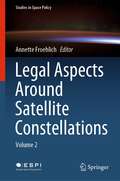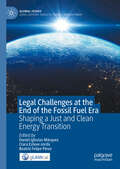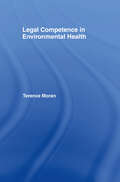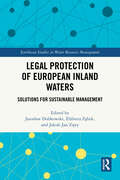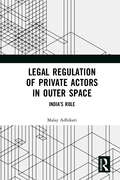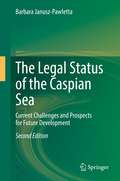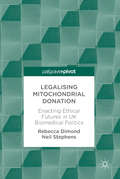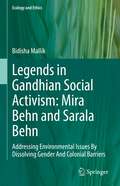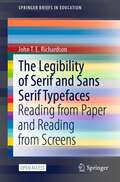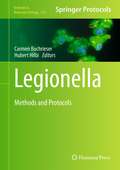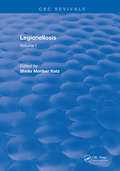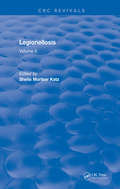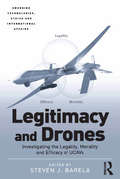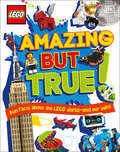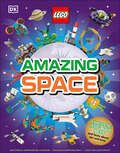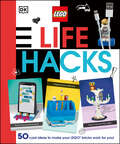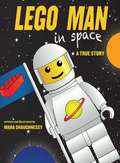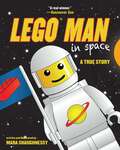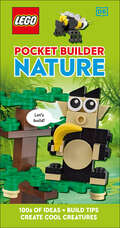- Table View
- List View
Legal Aspects Around Satellite Constellations: Volume 2 (Studies in Space Policy #31)
by Annette FroehlichThis book is the highly anticipated sequel to the previous volume under the same title, dedicated to presenting a diverse range of timely and valuable contributions on the legal and policy related questions evoked by satellite constellations, including emerging mega-constellations. Given the proliferation of activities in the field of satellite constellations, and the critical roles they play in supporting and enabling communication, navigation, disaster monitoring, Earth observation, security and scientific activities, the insights of legal and policy experts from around the world have been gathered in this second volume to help expand the scientific literature in this precious field. Topics range from legal obstacles and opportunities facilitating small satellite enterprise for emerging space actors, international cooperation in the compatibility and interoperability of navigation systems, the designation of satellite constellations as critical space infrastructure, to an analysis of the paradigm shift which has occurred over the last decade to make the proliferation of small satellite constellations possible, and more.
Legal Aspects of Implementing the Cartagena Protocol on Biosafety
by Marie-Claire Cordonier Segger Frederic Perron-Welch Christine FrisonThis book, the first in a new series that focuses on treaty implementation for sustainable development, examines key legal aspects of implementing the Cartagena Protocol on Biosafety to the UN Convention on Biological Diversity (CBD) at national and international levels. The volume provides a serious contribution to the current legal and political academic debates on biosafety by discussing key issues under the Cartagena Protocol on Biosafety that affect the further design of national and international law on biosafety, and analyzing recent progress in the development of domestic regulatory regimes for biosafety. It also examines the legal, political, economic, and practical challenges and solutions encountered in recent efforts to develop and implement domestic biosafety regulations, with a focus on developing countries. In the year of the fifth UN Meeting of the Parties to the Cartagena Protocol on Biosafety, at the signature of a new Nagoya-Kuala Lumpur Protocol on Liability and Redress, this timely book examines recent developments in biosafety law and policy.
Legal Challenges at the End of the Fossil Fuel Era: Shaping a Just and Clean Energy Transition (Global Issues)
by Daniel Iglesias Márquez Clara Esteve-Jordà Beatriz Felipe PérezThis edited collection proposes a wide range of approaches to address the legal issues pertaining to the end of the fossil fuel era. While the fossil fuel era is coming to an end both because of the inherent limits of its resources and because of the need to prevent to further pump out CO2 in an already saturated atmosphere, the legal dispositions to ensure an ordered and rational shift toward cleaner energy still need to be developed. Not only in relation to CO2 emissions themselves but also in relation to the manifold issues related to environmental justice in an era of global climate change and global warming. This book is unique in that it provides a theoretical framework but also works to address cutting edge issues through a series of case studies.
The Legal Challenges of the Fourth Industrial Revolution: The European Union's Digital Strategy (Law, Governance and Technology Series #57)
by Dário Moura Vicente Sofia de Vasconcelos Casimiro Chen ChenThis book explores the concept of a fourth industrial revolution as an expression of the current technological, economic, and social changes sparked by the growing interconnectivity and intelligent automation that have emerged in the 21st century. It seeks to identify and explain the legal challenges posed by this phenomenon in four main areas: content, economy, security, and people.Part I, Content, considers e.g. the problems posed by new uses of protected works in the digital environment, and the new rules on liability for intermediary services contained in the Digital Services Act.Part II, Economy, is particularly concerned with the regulation of Big Tech in the EU’s Digital Markets Act, ecommerce and EU consumers’ rights, the taxation of online platforms, and digital advertising.Part III, Security, addresses the European Union Strategy for Cybersecurity, the use of biometric data systems and facial recognition technologies for law enforcement purposes, and the security implications of the Proposal for an EU Regulation on Artificial Intelligence, as well as the challenges entailed by the European Union’s positioning itself as a major cyber defence actor.Part IV, People, discusses the Data Protection Litigation System under the GDPR, the right to disconnect from work, the proposed EU Catalogue of Fundamental Digital Rights, the countering of terrorist propaganda online through the TERREG and the DSA, and AI and Fundamental Rights.
Legal Competence in Environmental Health
by Terence MoranLegal Competence in Environmental Health assists the environmental health professional in understanding the operation of English law and navigating through some of its complexities. It covers those aspects of the work which are regulated by legal principles but not found in a single statute.
Legal Instruments for Sustainable Soil Management in Africa (International Yearbook of Soil Law and Policy)
by Harald Ginzky Oliver C. Ruppel Emmanuel Kasimbazi Hadijah Yahyah Robert KibugiThis book presents an important discussion on future options for sustainable soil management in Africa from various perspectives, including national soil protection regulations, the role of tenure rights, the work of relevant international institutions such as the UNCCD and FAO, and regional and international cooperation. This first volume of the new subseries Regional Perspectives to the International Yearbook of Soil Law and Policy includes contributions by African and international experts alike. Given the range of key topics covered, the book offers an indispensable tool for all academics, legislators and policymakers working in this field. The “International Yearbook of Soil Law and Policy – Regional Perspectives” series discusses central questions in law and politics that concern the protection and sustainable management of soil and land in different regions of the world.
Legal Protection of European Inland Waters: Solutions for Sustainable Management (Earthscan Studies in Water Resource Management)
by Jarosław Dobkowski Elżbieta Zębek Jakub Jan ZiętyThis book examines the legal protection and management of inland waters in Europe.With inland waters facing a range of significant threats, including from climate change, pollution, and overexploitation, this volume discusses legal solutions for protecting and managing these inland waters. It presents comparative studies from a range of European countries, including the Czech Republic, Germany, France, Lithuania, Poland, and Spain, with each chapter examining the legal status and legal instruments being implemented in each country, allowing for easy cross-comparison. Topics covered include surface water management and protection, water quality and monitoring, management of hazardous substances, and crisis management. Through these unique comparative studies, the volume highlights legal solutions which can be adopted by other nations and used as models for wider implementation across Europe. In doing so, this book offers important recommendations for changing water law to ensure a water secure future in Europe.This book will be of great interest to students and scholars of water law, water resource management, environmental policy, and environmental conservation.
Legal Regulation of Private Actors in Outer Space: India’s Role
by Malay AdhikariThe book addresses legal issues and challenges in using Space Technology. Especially covered are the provisions of International Space Law and few national space legislations to regulate private actors in outer space. The key chapters covered are history of space regulations, private actors in space, legal issues for such actors, regulating these issues outside India, and the same in India. In concluding chapter, the author has worked out some recommendations.The book would be of immense use to people especially startups in private space industry; students, faculties and scholars of Space Law and Policy, Space Security, Defence and Security Studies.Please note: Taylor & Francis does not sell or distribute the Hardback in India, Pakistan, Nepal, Bhutan, Bangladesh and Sri Lanka
The Legal Status of the Caspian Sea: Current Challenges and Prospects for Future Development
by Barbara Janusz-PawlettaThis book analyzes the legal and economic situation concerning the removal and allocation of natural resources in the Caspian Sea – the largest enclosed body of salt water in the world, which not only constitutes a fragile ecosystem with tremendous fishery resources, but is also rich in oil and gas deposits. After more than 20 years of negotiations, the five littoral states signed the Convention on the Legal Status of the Caspian Sea in August 2018.This book investigates whether this long-awaited agreement may pave a way forward for the sustainable and peaceful development of the Caspian region. The newly introduced regulations on the delimitation of the boundaries, on the Caspian Sea’s natural resources (especially its fossil fuels) and on the transport of goods by shipping and submarine pipelines, are of utmost importance for the successful participation of the Caspian states in global markets. In addition to a detailed analysis of the Convention, the book offers an up-to-date and comprehensive overview of the historical background and current status of issues that are of critical importance for the region’s development and security.
Legalising Mitochondrial Donation: Enacting Ethical Futures In Uk Biomedical Politics
by Rebecca Dimond Neil StephensIn 2015 the UK became the first country in the world to legalise mitochondrial donation, a controversial germ line reproductive technology to prevent the transmission of mitochondrial disease. Dimond and Stephens track the intense period of scientific and ethical review, public consultation and parliamentary debates preceeding the decision. They draw on stakeholder accounts and public documents to explore how patients, professionals, institutions and publics mobilised within ‘for’ and ‘against’ clusters, engaging in extensive promissory, emotional, bureaucratic, ethical, embodied and clinical labour to justify competing visions of an ethical future. They describe how this decision is the latest iteration of a UK sociotechnical imaginary in which the further liberalization of human embryo research and use is rendered legitimate and ethical through modes of consultation and permissive but strictly regulated licensing. Overall, this book presents a timely, multi-dimensional, and sociological account of a globally significant landmark in the history of human genetics, and will be relevant to those with an interest in genetics, Science, Technology and Society, the sociology of medicine, reproductive technology, and public policy debate.
Legally Poisoned: How the Law Puts Us at Risk from Toxicants
by Carl F. CranorTake a random walk through your life and you’ll find it is awash in industrial, often toxic, chemicals. Sip water from a plastic bottle and ingest bisphenol A. Prepare dinner in a non-stick frying pan or wear a layer of Gore-Tex only to be exposed to perfluorinated compounds. Hang curtains, clip your baby into a car seat, watch television—all are manufactured with brominated flame-retardants. Cosmetic ingredients, industrial chemicals, pesticides, and other compounds enter our bodies and remain briefly or permanently. Far too many suspected toxic hazards are unleashed every day that affect the development and function of our brain, immune system, reproductive organs, or hormones. But no public health law requires product testing of most chemical compounds before they enter the market. If products are deemed dangerous, toxicants must be forcibly reduced or removed—but only after harm has been done. In this scientifically rigorous legal analysis, Carl Cranor argues that just as pharmaceuticals and pesticides cannot be sold without pre-market testing, other chemical products should be subject to the same safety measures. Cranor shows, in terrifying detail, what risks we run, and that it is entirely possible to design a less dangerous commercial world.
Legends in Gandhian Social Activism: Addressing Environmental Issues By Dissolving Gender And Colonial Barriers (Ecology and Ethics)
by Bidisha MallikThis book is about Madeleine Slade (1892-1982) and Catherine Mary Heilemann (1901-1982), two English associates of Mohandas K. (Mahatma) Gandhi (1869-1948), known in India as Mira Behn and Sarala Behn. The odysseys of these women present a counternarrative to the forces of imperialism, colonialism, capitalism, and globalized development. The book examines their extraordinary journey to India to work with Gandhi and their roles in India’s independence movement, their spiritual strivings, their independent work in the Himalayas, and most importantly, their contribution to the evolution of Gandhian philosophy of socio-economic reconstruction and environmental conservation in the present Indian state of Uttarakhand. The author shows that these women developed ideas and practices that drew from an extensive intellectual terrain that cannot be limited to Gandhi’s work. She delineates directions in which Gandhian thought and experiments in rural development work and visions of a new society evolved through the lives, activism, and written contributions of these two women. Their thought and practice generated a new cultural consciousness on sustainability that had a key influence in environmental debates in India and beyond and were responsible for two of the most important environmental movements of India and the world: the Chipko Movement or the movement against commercial green felling of trees by hugging them, and the protest against the Tehri high dam on the Bhagirathi River. To this day, their teachings and philosophies constitute a useful and significant contribution to the search for and implementation of global ideas of ecological conservation and human development.
Legends of the Security Services Industry: Profiles in Leadership
by Keith Oringer Michael HymansonThe global contract security market now totals over $200 billion, with the number of private security officers exceeding that of public law enforcement officers. But this wasn’t always the case.Legends of the Security Services Industry: Profiles in Leadership presents the unique stories of 15 industry legends, who transformed the industry from early private detective and small night watch companies into large-scale contract security companies. The large-scale companies include, but are not limited to, Pinkerton, Burns International, The Wackenhut Corporation, Guardsmark, Wells Fargo, and U.S. Security Associates; as well as today’s leading security companies, Allied Universal, Securitas, G4S, Prosegur, and GardaWorld.The book begins in the nineteenth century, with early U.S. legendary detectives: Allan Pinkerton and William Burns. Then, the book focuses largely from the mid-twentieth century to the present, where successive generations of legends built large-scale contract security companies which competed with, and then acquired, those formed by the early legends. Part II legends George Wackenhut, Ira Lipman, and Tom Wathen; Part III legends, Charles Schneider, Kenneth W. Oringer, William Whitmore, Jr., and Albert Berger; and Part IV, Scandinavian legends Jørgen Philip-Sørensen, Lars Nørby Johansen, and Thomas Berglund, all developed major security companies. Part V includes current global security leaders Helena Revoredo Gut, Stephan Crétier, and Steve Jones. Part VI reviews the timelines and successful leadership of these legendary leaders, with a look at the future of the industry.The legends’ personal stories contain colorful insight into how they capitalized on the industry’s explosive growth. While each generation of legends faced unique social and competitive landscapes, their personal stories illustrate how they respectively succeeded. Their leadership and management prowess enabled them to achieve great success, as they displayed vision and achieved their goals through grit, determination, hard work, charisma, organizational skills, and calculated risk-taking.Each chapter has been extensively researched and includes firsthand accounts based on interviews with living legends, colleagues, and family of deceased legends. Personal, company and signature event photos add further color to the moving narrative. Their stories are not only highly interesting, but also provide a framework for current leaders, and the next generation of entrepreneurs, on how to build and lead large-scale security service companies. With a Foreword from Robert D. McCrie, PhD, longtime John Jay Professor and editor of the renowned industry publication The Security Letter.
The Legibility of Serif and Sans Serif Typefaces: Reading from Paper and Reading from Screens (SpringerBriefs in Education)
by John T. RichardsonThis open access book provides a detailed and up-to-date account of the relevant literature on the legibility of different kinds of typefaces, which goes back over 140 years in the case of reading from paper and more than 50 years in the case of reading from screens. It describes the origins of serif and sans serif styles in ancient inscriptions, their adoption in modern printing techniques, and their legibility in different situations and in different populations of readers. It also examines recent research on the legibility of serif and sans serif typefaces when used with internet browsers, smartphones and other hand-held devices. The book investigates the difference in the legibility of serif typefaces and sans serif typefaces when they are used to produce printed material or when they are used to present material on computer monitors or other screens and it explores the differences in readers’ preferences among typefaces. The book’s main focus is on the psychology of reading, but there are clear implications for education and publishing. Indeed, the book can be read with benefit by anyone concerned with communicating with others through written text, whether it is printed on paper or displayed on computer screens.
Legionella
by Carmen Buchrieser Hubert HilbiThis Methods in Molecular BiologyTM series book presents methods specifically adapted and developed for the study of distinct features of L. pneumophila. Includes materials lists, reproducible protocols, and notes on troubleshooting and pitfalls.
Legionellosis: Volume I
by KatzLegionellosis is a text in two volumes that presents the modern viewpoint of the agent and the disease. It also chronicles the history of the discovery of Legionella pneumophila. Volume 1 discusses current aspects of the microbe including taxonomy, morphology, biochemistry, and physiology. It also discusses the illness including clinical features, pathology, and therapy. Volume II details the laboratory diagnosis, epidemiology, and pathology. The contributors are amongst the most eminent scientists in their respective fields.
Legionellosis: Volume II
by KatzLegionellosis is a text in two volumes that presents the modern viewpoint of the agent and the disease. It also chronicles the history of the discovery of Legionella pneumophila. Volume 1 discusses current aspects of the microbe including taxonomy, morphology, biochemistry, and physiology. It also discusses the illness including clinical features, pathology, and therapy. Volume II details the laboratory diagnosis, epidemiology, and pathology. The contributors are amongst the most eminent scientists in their respective fields.
Legislative XML for the Semantic Web
by Giovanni Sartor Maria Angela Biasiotti Monica Palmirani Enrico FrancesconiThis volume examines the basic layers of the standard-based creation and usage of legislation. In particular, it addresses the identification of legislative documents, their structure, the basic metadata and legislative changes. Since mature technologies and established practices are already in place for these layers, a standard-based approach is a necessary aspect of the up-to-date management of legislative resources. Starting out with an overview of the context for the use of XML standards in legislation, the book next examines the rationale of standard-based management of legislative documents. It goes on to address such issues as naming, the Akoma-Ntoso document model, the contribution of standard-based document management to handling legislative dynamics, meta-standards and interchange standards. The volume concludes with a discussion of semantic resources and a review on systems and projects.
Legitimacy and Drones: Investigating the Legality, Morality and Efficacy of UCAVs (Emerging Technologies, Ethics and International Affairs)
by Steven J. BarelaUnmanned combat air vehicles, or in common parlance 'drones', have become a prominent instrument in US efforts to counter an objective (and subjective) cross-border terrorist threat with lethal force. As a result, critical questions abound on the legitimacy of their use. In a series of multidisciplinary essays by scholars with an extensive knowledge of international norms, this book explores the question of legitimacy through the conceptual lenses of legality, morality and efficacy, it then closes with the consideration of a policy proposal aimed at incorporating all three indispensable elements. The importance of this inquiry cannot be overstated. Non-state actors fully understand that attacking the much more powerful state requires moving the conflict away from the traditional battlefield where they are at an enormous disadvantage. Those engaging in terrorism seek to goad the ruling government into an overreaction, or abuse of power, to trigger a destabilization via an erosion of its legitimacy. Thus defending the target of legitimacy”in this case, insuring the use of deadly force is constrained by valid limiting principles”represents an essential strategic interest. This book seeks to come to grips with the new reality of drone warfare by exploring if it can be used to preserve, rather than eat away at, legitimacy. After an extensive analysis of the three key parameters in twelve chapters, the practical proposition of establishing a 'Drone Court' is put forward and examined as a way of pursuing the goal of integrating these essential components to defend the citizenry and the legitimacy of the government at the same time.
LEGO Amazing But True: Fun Facts About the LEGO World - and Our Own!
by Elizabeth Dowsett Julia March Catherine SaundersAn eye-popping fact book with a LEGO twist – discover amazing information about the world around us with the help of LEGO minifigures and bricks! Did you know a Goliath spider weighs the same as 75 2x4 LEGO bricks? Or that LEGO bricks and minifigures in various forms have travelled to Saturn, Mars, and the International Space Station? And did you know the Taj Mahal gets a mud pack treatment to remove pollution stains? Or that hummingbirds are the only birds that fly backwards? From unbelievable space and nature facts, to mind-boggling inventions and technology trivia, children will be amazed and entertained with incredible information about the LEGO world and our own. ©2022 The LEGO Group.
LEGO Amazing Space: Fantastic Building Ideas and Facts About Our Amazing Universe
by Arwen HubbardDiscover the furthest frontiers of space – and learn to build the Universe’s most incredible sights!Explore the wonders of the Universe without even putting on a spacesuit! Take a tour of planets, stars, galaxies, and even alien worlds far away from Earth. Discover how the Big Bang created all the worlds that make up the Universe; find out what’s in a black hole and learn how stars are born and why they die. Go on a spacewalk, drive a Mars Rover, dock with the International Space Station, and launch a probe to make contact with extraterrestrials! With more than 150 out-of-this-world LEGO models to inspire you, what will you build?
LEGO Life Hacks: 50 Cool Ideas to Make Your LEGO Bricks Work for You!
by Julia MarchGet ready to hack your life, LEGO style!This ebook is bursting with more than 50 smart ideas to streamline your life and accessorize your space. You'll find stationery hacks help you organize your desk, cool ideas to make the most of your tech, and gadgets to blitz your boring chores. From a speaker that amplifies your phone, a weekly planner made of LEGO bricks, and a catapult that flings paper into the wastepaper basket, these ideas will make your LEGO bricks work for you. Discover ways to personalize your living space, from photo frames to brick-built houseplants, plus smart ways to display your favorite LEGO builds and minifigures. These creative ideas will inspire you to use your LEGO bricks in awesome new ways. With amazing images, easy to follow step-by-step instructions, and handy tips for further building, this ebook will take your building to the next level. ©2021 The LEGO Group.
LEGO Man in Space: A True Story
by Mara ShaughnessyThe true story of two boys who launched a Lego Man into space! With over 3 million views on YouTube and covered by almost every major news outlet in the world, the story of how two boys launched a Lego man 80,000 feet
LEGO Man in Space: A True Story
by Mara ShaughnessyThe true story of two boys who launched a LEGO man into space! With over 3 million views on YouTube and covered by almost every major news outlet in the world, the story of how two boys, Matthew Ho and Asad Muhammad, launched a LEGO man 80,000 feet into space using a weather balloon, a homemade parachute, and a video camera is truly an inspirational story for all ages. Now you can follow along with the plucky little &“Legonaut&” as he explains just how he became the very first LEGO Man in Space. With bright, original illustrations and loads of fun space facts and activities, kids everywhere will go wild for this true tale of a Legonaut legend and his space adventure. A triumph of science and curiosity, this children&’s book is the first and only book to tell the story of how Mathew Ho and Asad Muhammad accomplished this amazing feat.LEGO Man in Space includes a resource guide for teachers with science activities, classroom crafts and games, and more!
LEGO Pocket Builder Nature: Create Cool Creatures (LEGO Pocket Builder)
by Tori KosaraA one-stop introduction to building with LEGO® bricks for young builders, packed with tips and tricks for making LEGO models of plants, animals, and natural wondersBuild your LEGO® skills with this bitesize guide!Become a LEGO® building expert with stacks of facts, tips, and tricks at your fingertips – no previous building experience required! Get out your bricks and be inspired to build your favorite plants, animals, and natural wonders including a happy hippo, a cool cactus, an incredible volcano, and much more.Each LEGO Pocket Builder book is packed with images of fun-to-make models, building techniques, advice, and inspiration – plus they are perfectly pocket-sized for building anywhere – even on-the-go. Grab your LEGO bricks and go wild!©2022 The LEGO Group.
